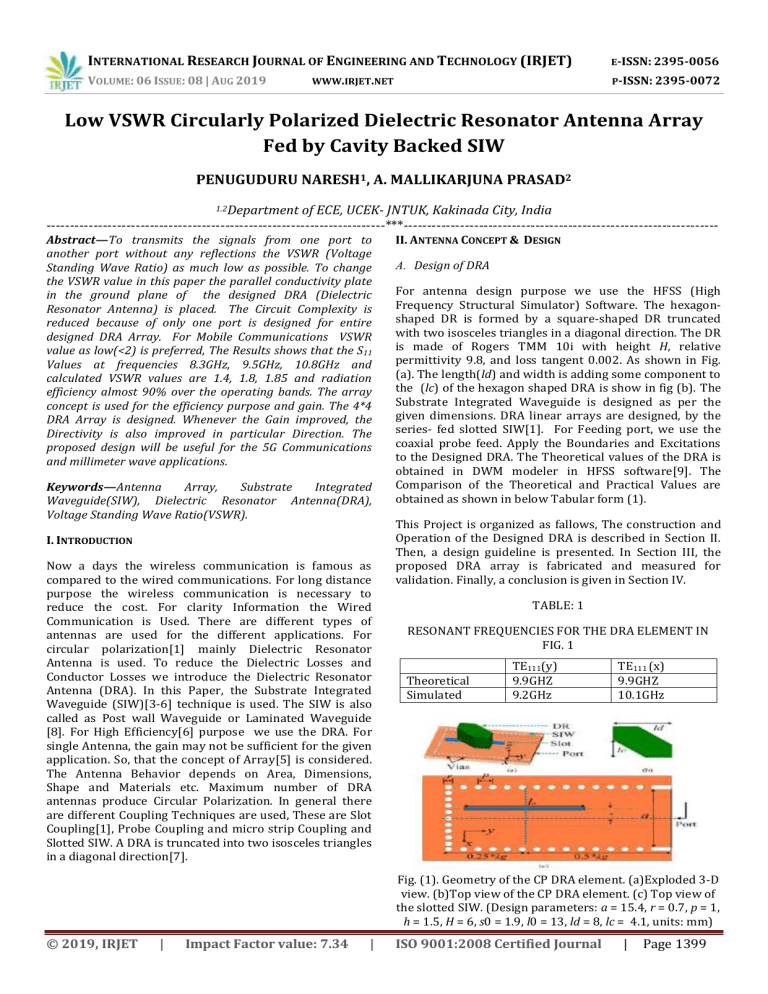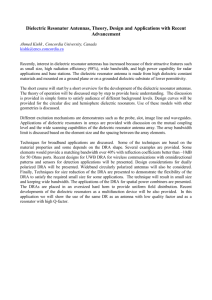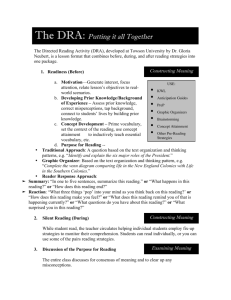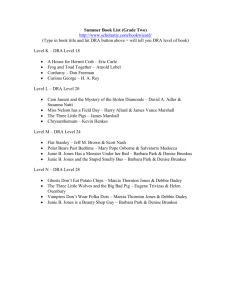IRJET-Low VSWR Circularly Polarized Dielectric Resonator Antenna Array Fed by Cavity Backed SIW
advertisement

INTERNATIONAL RESEARCH JOURNAL OF ENGINEERING AND TECHNOLOGY (IRJET) E-ISSN: 2395-0056 VOLUME: 06 ISSUE: 08 | AUG 2019 P-ISSN: 2395-0072 WWW.IRJET.NET Low VSWR Circularly Polarized Dielectric Resonator Antenna Array Fed by Cavity Backed SIW PENUGUDURU NARESH1, A. MALLIKARJUNA PRASAD2 1.2Department of ECE, UCEK- JNTUK, Kakinada City, India ------------------------------------------------------------------------***------------------------------------------------------------------Abstract—To transmits the signals from one port to another port without any reflections the VSWR (Voltage Standing Wave Ratio) as much low as possible. To change the VSWR value in this paper the parallel conductivity plate in the ground plane of the designed DRA (Dielectric Resonator Antenna) is placed. The Circuit Complexity is reduced because of only one port is designed for entire designed DRA Array. For Mobile Communications VSWR value as low(<2) is preferred, The Results shows that the S11 Values at frequencies 8.3GHz, 9.5GHz, 10.8GHz and calculated VSWR values are 1.4, 1.8, 1.85 and radiation efficiency almost 90% over the operating bands. The array concept is used for the efficiency purpose and gain. The 4*4 DRA Array is designed. Whenever the Gain improved, the Directivity is also improved in particular Direction. The proposed design will be useful for the 5G Communications and millimeter wave applications. Keywords—Antenna Array, Substrate Integrated Waveguide(SIW), Dielectric Resonator Antenna(DRA), Voltage Standing Wave Ratio(VSWR). I. INTRODUCTION Now a days the wireless communication is famous as compared to the wired communications. For long distance purpose the wireless communication is necessary to reduce the cost. For clarity Information the Wired Communication is Used. There are different types of antennas are used for the different applications. For circular polarization[1] mainly Dielectric Resonator Antenna is used. To reduce the Dielectric Losses and Conductor Losses we introduce the Dielectric Resonator Antenna (DRA). In this Paper, the Substrate Integrated Waveguide (SIW)[3-6] technique is used. The SIW is also called as Post wall Waveguide or Laminated Waveguide [8]. For High Efficiency[6] purpose we use the DRA. For single Antenna, the gain may not be sufficient for the given application. So, that the concept of Array[5] is considered. The Antenna Behavior depends on Area, Dimensions, Shape and Materials etc. Maximum number of DRA antennas produce Circular Polarization. In general there are different Coupling Techniques are used, These are Slot Coupling[1], Probe Coupling and micro strip Coupling and Slotted SIW. A DRA is truncated into two isosceles triangles in a diagonal direction[7]. II. ANTENNA CONCEPT & DESIGN A. Design of DRA For antenna design purpose we use the HFSS (High Frequency Structural Simulator) Software. The hexagonshaped DR is formed by a square-shaped DR truncated with two isosceles triangles in a diagonal direction. The DR is made of Rogers TMM 10i with height H, relative permittivity 9.8, and loss tangent 0.002. As shown in Fig. (a). The length(ld) and width is adding some component to the (lc) of the hexagon shaped DRA is show in fig (b). The Substrate Integrated Waveguide is designed as per the given dimensions. DRA linear arrays are designed, by the series- fed slotted SIW[1]. For Feeding port, we use the coaxial probe feed. Apply the Boundaries and Excitations to the Designed DRA. The Theoretical values of the DRA is obtained in DWM modeler in HFSS software[9]. The Comparison of the Theoretical and Practical Values are obtained as shown in below Tabular form (1). This Project is organized as fallows, The construction and Operation of the Designed DRA is described in Section II. Then, a design guideline is presented. In Section III, the proposed DRA array is fabricated and measured for validation. Finally, a conclusion is given in Section IV. TABLE: 1 RESONANT FREQUENCIES FOR THE DRA ELEMENT IN FIG. 1 Theoretical Simulated TE111(y) 9.9GHZ 9.2GHz TE111 (x) 9.9GHZ 10.1GHz Fig. (1). Geometry of the CP DRA element. (a)Exploded 3-D view. (b)Top view of the CP DRA element. (c) Top view of the slotted SIW. (Design parameters: a = 15.4, r = 0.7, p = 1, h = 1.5, H = 6, s0 = 1.9, l0 = 13, ld = 8, lc = 4.1, units: mm) © 2019, IRJET | Impact Factor value: 7.34 | ISO 9001:2008 Certified Journal | Page 1399 INTERNATIONAL RESEARCH JOURNAL OF ENGINEERING AND TECHNOLOGY (IRJET) E-ISSN: 2395-0056 VOLUME: 06 ISSUE: 08 | AUG 2019 P-ISSN: 2395-0072 WWW.IRJET.NET B. Design of DRA array Fig (b) shows geometry of the DRA array. The distance between two elements is about λw/2, where λw[6] is the guide wavelength for the TE440 mode, corresponding to the resonance frequency in the square waveguide cavity[4]. Every radiating DR in the array is fed in phase, and the main lobe is not tilted. The waveguide cavity is directly fed by a 50 Ω SMA connector. Optimized by ANSYS HFSS[9]. When the gap is given between antennas in Array both real and imaginary parts of the input impedances decrease because of parallel and series capacitance effects. Due to this change the simulated frequencies will be changes by changing the vertical conducting plate into the shape of E, L, T etc. The simulated frequencies are 8.3GHz, 9.5GHz, 10.8GHz for considering |S11| >= −10 dB. Also, the VSWR graph is plotted at the 8.GHz, 9.5GHz, 10.8GHz are shown in fig (4) Fig (4): VSWR The radiation efficiency[6] almost nearly equal to the 90% value. For finding the imaginary and real values the Smith chart is preferred. The Smith Chart for the designed DRA Array is shown in fig(5) Fig (2);Designed DRA Array C. Design Guideline The design formulas for the DRA is calculated in DWM mode and used to calculate the TEx111- and TEy111mode resonant frequencies[7]. In this paper, Initially find the parameters of the DRA antenna i.e resonance frequency, gain, VSWR and electric filed distribution of Antenna. After that, find out the DRA Array Parameters with SIW slot. Note down the all the parameters in tabular form. The Design of the DRA using SIW is completed Fig (5): Smith Chart IV. CONCLUSION III. SIMULATION RESULTS Parameters of the DRA array are simulated by using the software ANSYS HFSS. In this paper Simulated reflection coefficients are measured As depicted in the figure(3). A hexagon shaped DRA is designed by using back cavity SIW. A 4*4 DRA Array is also designed. The benefits of designed antenna are Low VSWR, small size, easy design, high gain and high efficiency over the frequencies 8.3GHz, 9.5GHz, 10.8GHz with the values of VSWR 1.47, 1.8, 1.8. The radiation efficiency of designed DRA is almost 90%. The designed characteristics of the antenna will be changed by changing the shape of the Vertical Conducting plate with the shape of E, T, L etc. References [1] L Lu, Y-C Jiao Z-B, Weng, H. Zhang and C- Y Cui “ Design of lowsidelobe circularly-polarized loop linear array fed by the slotted SIW”, IEEE Antennas Wireless Propag Let, vol.16 pp,537-540, 2017. [2] W.M. Abdel-Wahab, D.Busuioc, and S. Safavi-Naeini, “Millimeter-wave high radiation efficiency planar Fig (3): Return Losses © 2019, IRJET | Impact Factor value: 7.34 | ISO 9001:2008 Certified Journal | Page 1400 INTERNATIONAL RESEARCH JOURNAL OF ENGINEERING AND TECHNOLOGY (IRJET) E-ISSN: 2395-0056 VOLUME: 06 ISSUE: 08 | AUG 2019 P-ISSN: 2395-0072 WWW.IRJET.NET waveguide series fed dielectric resonator antenna(DRA) array: Analysis, design and measurements”, IEEE Trans. Antennas Propag, vol.59, no 8,pp. 2834-2843 Aug 2011. [3] J. K. Xu, M.Wang, H.K, Huang, and W.Wu “Circularly polarized patch array fed by slotted waveguide”, IEEE Antennas Wireless.Propag Let vol 14, pp. 8-11-2015 [4] Y.Lang, S-W. Qu, and J-X Chen, “wideband circularly polarized substrate integrated cavity-backed antenna array”, IEEE Antennas wireless propag let, Vol 13,pp 1513-1516, 2014. [5] L, Lu, Y-C Jiao H,Zhang, R-Q Wang and T, Li “Wideband circularly polarized antenna with stair shaped dielectrci resonator and open ended slot ground”, IEEE Antennas Wireless Propag, Let vol16.15,pp. 17551758, 2016 [6] Chao-YiCui, and Rui-Qj Wang, Liang Lu, Li Zhang, ”High Efficiency Circular Polarized dielectric resonator antenna array fed by the cavity backed SIW”, IEEE Antennas and wireless propagation let, vol17 no. 7 July2018. [7] J. F. Legier, P. Kennis, S. Toutain, and J. Citerne, “Resonant fre- quencies of rectangular dielectric resonators,” IEEE Transactions on Microwave Theory and Techniques, vol. 28, no. 9, pp. 1031– 1034, 1980. [8] Dominic Deslandes and Ke Wu “ Accurate Modeling, Wave Mechanisms, and Design Considerations of a Substrate Integrated Waveguide”, “ IEEE Transactions on Microwave Theory and Techniques vol. 54, No. 6 June 2006. [9] ANSYS HFSS software PDF document for Learners. © 2019, IRJET | Impact Factor value: 7.34 | ISO 9001:2008 Certified Journal | Page 1401



